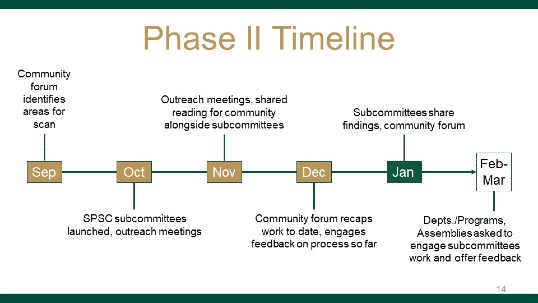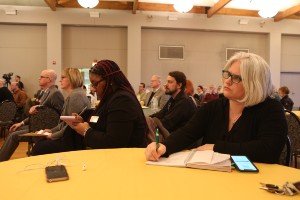Setting the pace in strategic planning
Katherine Switzer, who ran the Boston Marathon in 1967, famously inspires other runners with the advice to “put one foot in front of the other.” That is our approach in this year of strategic planning, though our stride varies from marathon speed to sprint. In some arenas, we move forward with the measured pace of a distance runner, confident that sustained and steady progress will be efficient in the long run. In others, we will need to pick up the pace even as we continue planning.
Phase II of planning: forecasting challenges and opportunities

Three subcommittees of the Strategic Planning Steering Committee (SPSC) have completed environmental scans in key mission areas: teaching & learning, research & innovation, flourishing & engagement. They compiled research and readings on the dominant trends facing higher education in the decade ahead. Then they assessed William & Mary’s internal position with respect to those trends.
Their results make for compelling reading. The subcommittees’ three wide-ranging, keenly observed and often provocative white papers were presented at a university-wide forum last month, broadcasted via livestream. The planning committee also released video modules on our financial model and enrollment trends, so that all in the community have access to the same core information the SPSC is working with.
Inviting input at a key inflection point

The Cabinet and the SPSC are digesting the findings of these subcommittees, identifying framing assumptions and problem statements to guide strategy development in phase III. We are also actively seeking input from every department and W&M’s four governing assemblies.
We invite all in our community to review and weigh in. What do you find powerful? What might you add? Where should we sprint? Where should we move more slowly to build momentum?
Emerging themes
During the February Board of Visitors meeting, I sketched out 5 of the themes that thread through each of the white papers, with remarkable consistency.
1. Collaborate
“By sharing their expertise with outside entities, faculty gain the opportunity to engage in difficult and timely problems, expand their research, and garner funding. These collaborations also provide students with research opportunities beyond the classroom.” – Teaching & Learning White Paper (pdf)
In the year ahead, we will look outward to identify new partnerships in the business, government and nonprofit sectors. Among our nearest and longest partners is the City of Williamsburg. At our strategic planning forum on February 12, we hosted leaders from the City to share their reactions to the trends articulated in the white papers.
2. Break down silos
“Organizational structures sometimes make it hard to communicate effectively, and to keep all interested groups informed and involved. Silos can inhibit the development of effective and inclusive collaborations.” – Flourishing & Engagement White Paper (pdf)
Our vision statement begins, “William & Mary transcends boundaries...” so we aim to dig deeper into this metaphor. What creates the felt sense of silos?
3. Cultivate an entrepreneurial mindset
“... an internal consulting capability … could address the full spectrum of new initiative exploration, ideation, and development through evaluating potential improved efficiencies and delivery of existing initiatives and services. In addition to fostering strategic growth, this resource could also redress bottlenecks that reduce effective time management among faculty and staff.” – Research & Innovation White Paper (pdf)
At our January 30 forum, a staff member broached this question: how we might speed the process from decision to execution at W&M? Three answers … First: be transparent about who is empowered to make a decision, and what stakeholders need input. Second, back a decision with a “business case” – a plan that shows the resources (human time among others) and results anticipated. Third, tolerate measured risk-taking and resilience, knowing that we will often move forward without perfect knowledge of outcomes.
4. Make the case for higher education: widely, creatively, convincingly
“In sum, university leaders must ... demonstrate clearly and convincingly that higher education prepares graduates simultaneously for career success, personal fulfillment, and practical engagement with urgent domestic and global problems.” – Teaching & Learning White Paper (pdf)
We need to claim our status as an exemplar of liberal arts and sciences education that prepares students with the range and human insight they will need as professionals and citizens in a rapidly changing world. Our recent positioning study provides the data to shape our narrative. Coming out of strategic planning, we must convey who we are and what we value in a way that is compelling to our key stakeholders – prospective students and families – friends and peers.
5. Ensure financial sustainability
“The university will need to develop increasingly flexible fiscal and organizational structures so that it can respond rapidly to sudden shifts in funding sources and expenses (e.g. benefits).” – Flourishing & Engagement White Paper (pdf)
Like most institutions of higher education, William & Mary’s main source of revenue is tuition. In the current enrollment landscape, tuition growth at recent levels will not be sustainable. So new sources of revenue and new efficiencies are needed in order to sustain excellence and ensure our university flourishes for all times coming.
In strategic planning, we may sprint in some stretches and choose a measured pace in others, but in both cases, let’s keep running apace.
Best regards,
Katherine A. Rowe
President














